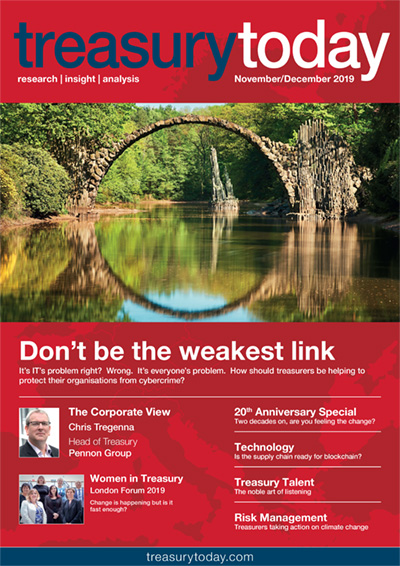Contents
- Editorial
- The game of risk
- Insight & Analysis
- Cyber-security: don’t be the weakest link
- 20th Anniversary Special
- Treasury Today turns 20
- Women in Treasury London Forum 2019
- Standing up for diversity and inclusion
- The Corporate View
- Corporate View: Chris Tregenna, Pennon Group
- Investment Briefing: Aviva Investors
- Reasons to be cheerful: matching enhanced returns with liquidity and security
- Technology
- Unblocking supply chains with DLT
- Risk Management
- Yes we can: treasury’s response to climate change
- Business Briefing: Analyste
- All together now: the power of niche forecasting technology
- Treasury Talent
- What did I just say? Practising the vital art of listening
- Back to Basics
- Interesting times: the treasurer’s perspective on interest rates
- Question Answered
- Question Answered: Innovate, don’t follow
- Market View
- Global economy confused by ‘great and unmatched wisdom’
Editorial
The game of risk
Life has its risks, without which, arguably, we wouldn’t progress. Think how far we have come in the worlds of medicine and travel, for example, as previous generations have wrestled the odds and overcome life-threatening hurdles, just so we can have life a bit easier.
Of course, the life we live now has its own panoply of risks to which we must all pay attention for the benefit of future generations. Perhaps none is more existential in its potential outcome than climate change.
Transformational cycles in Earth’s climate have existed for millennia, the last great shift taking place over 7,000 years ago with the ice age that heralded the modern climate era. It’s understood that much of the impact of such changes over the last 650,000 years or so have been attributed to small variations in Earth’s orbit subtly altering the amount of solar energy received by our planet.
However, according to the Intergovernmental Panel on Climate Change (IPCC) Fifth Assessment Report, the current warming trend has a “greater than 95% probability” of being man-made. Data gathered by NASA indicates that Earth’s average surface temperature has risen by 0.9°C since the late 19th century, the majority of this increase occurring in the past 35 years, with the five warmest years on record taking place since 2010.
We have a number of options when it comes to halting and possibly reversing the damaging effects of climate change. We can run around like headless chickens, panicking about it. We can refute the claims of scientists. We could do nothing because someone else will fix it. Or we can do something to help.
In this edition’s Risk Management feature, ‘Climate change and the treasurer’, we look at the latter option from a treasury perspective, exploring the kind of affirmative actions and preventative measures that the community can take to help make a difference. The options here are greater than you’d perhaps think.
Of course, climate change is the Big One, but risks abound (as they always will). In our Insight & Analysis article, we tap into the fear that is cybercrime, asking ‘where next?’
As digitisation proceeds apace, cyber-security is styling itself as possibly the major concern for corporations around the world. As a threat delivered straight from the hand of humankind, we surely have an earthly chance of combatting those who seek to disrupt (whatever their motivation). Treasurers need to know and understand what types of risk they face, the potential for damage, how the strategies used by cyber-criminals are evolving – and how technology itself is playing a role in helping mitigate these risks.
A major contributor to winning the fight against any significant foe (including climate change and cybercrime) is our capacity to listen and learn. Everyone has an opinion and most are happy to share it. But how many of us truly listen to what’s being said? Indeed, how many of us know how to listen to what’s being said? In this edition’s Treasury Talent article, we explore the noble art of listening, in the company of acknowledged experts.
Finally, Treasury Today is 20 this year! What better way to celebrate this than by looking back over the key issues of the day, before grabbing the crystal ball and predicting where we will be in the next 20 years? And who knows, maybe we will be casting our minds back to the Bad Old Days when climate change and cybercrime dominated our thoughts!


